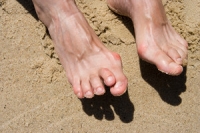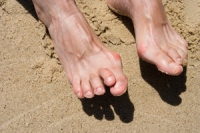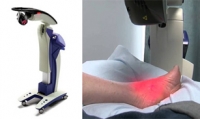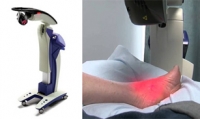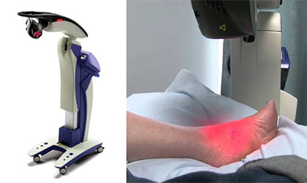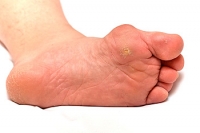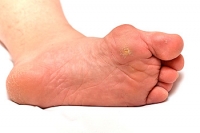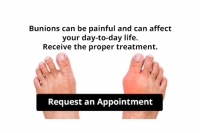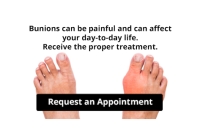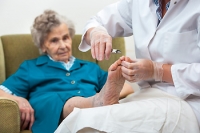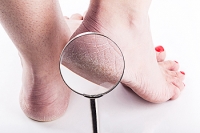
Blog (825)
What Toe Does Hammertoe Typically Affect?
The medical condition known as hammertoe typically affects the second toe. It is defined as a bone deformity that causes the toe to bend in a downward position. The affected joint can become stiff and enlarge if it should rub against the shoes. A common reason why hammertoe would develop can include wearing shoes that do not have adequate room for the toes to move freely in. The tendons in the toe may become shortened as a result of wearing these types of shoes, and the patient may experience muscle balance. Mild relief may be found when stretching exercises are frequently performed. This is beneficial in lengthening the tendons that may be tight. Some patients find it can help to wear orthotics, which aid in supporting the arch. If you have developed hammertoe, it is advised that you seek the counsel of a podiatrist who can guide you in beginning the correct treatment.
Hammertoes can be a painful condition to live with. For more information, contact Dr. Kenneth Donovan of Advanced Care Foot and Ankle. Our doctor will answer any of your foot- and ankle-related questions.
Hammertoe
Hammertoe is a foot deformity that occurs due to an imbalance in the muscles, tendons, or ligaments that normally hold the toe straight. It can be caused by the type of shoes you wear, your foot structure, trauma, and certain disease processes.
Symptoms
- Painful and/or difficult toe movement
- Swelling
- Joint stiffness
- Calluses/Corns
- Physical deformity
Risk Factors
- Age – The risk of hammertoe increases with age
- Sex – Women are more likely to have hammertoe compared to men
- Toe Length – You are more likely to develop hammertoe if your second toe is longer than your big toe
- Certain Diseases – Arthritis and diabetes may make you more likely to develop hammertoe
Treatment
If you have hammertoe, you should change into a more comfortable shoe that provides enough room for your toes. Exercises such as picking up marbles may strengthen and stretch your toe muscles. Nevertheless, it is important to seek assistance from a podiatrist in order to determine the severity of your hammertoe and see which treatment option will work best for you.
If you have any questions, please feel free to contact one of our offices located in Warren, Livingston, and Toms River, NJ . We offer the newest diagnostic and treatment technologies for all your foot care needs.
What Toe Does Hammertoe Typically Affect?
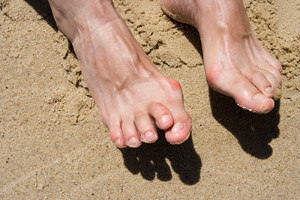 The medical condition known as hammertoe typically affects the second toe. It is defined as a bone deformity that causes the toe to bend in a downward position. The affected joint can become stiff and enlarge if it should rub against the shoes. A common reason why hammertoe would develop can include wearing shoes that do not have adequate room for the toes to move freely in. The tendons in the toe may become shortened as a result of wearing these types of shoes, and the patient may experience muscle balance. Mild relief may be found when stretching exercises are frequently performed. This is beneficial in lengthening the tendons that may be tight. Some patients find it can help to wear orthotics, which aid in supporting the arch. If you have developed hammertoe, it is advised that you seek the counsel of a podiatrist who can guide you in beginning the correct treatment.
The medical condition known as hammertoe typically affects the second toe. It is defined as a bone deformity that causes the toe to bend in a downward position. The affected joint can become stiff and enlarge if it should rub against the shoes. A common reason why hammertoe would develop can include wearing shoes that do not have adequate room for the toes to move freely in. The tendons in the toe may become shortened as a result of wearing these types of shoes, and the patient may experience muscle balance. Mild relief may be found when stretching exercises are frequently performed. This is beneficial in lengthening the tendons that may be tight. Some patients find it can help to wear orthotics, which aid in supporting the arch. If you have developed hammertoe, it is advised that you seek the counsel of a podiatrist who can guide you in beginning the correct treatment.
Hammertoes can be a painful condition to live with. For more information, contact Dr. Kenneth Donovan of Advanced Care Foot and Ankle. Our doctor will answer any of your foot- and ankle-related questions.
Hammertoe
Hammertoe is a foot deformity that occurs due to an imbalance in the muscles, tendons, or ligaments that normally hold the toe straight. It can be caused by the type of shoes you wear, your foot structure, trauma, and certain disease processes.
Symptoms
- Painful and/or difficult toe movement
- Swelling
- Joint stiffness
- Calluses/Corns
- Physical deformity
Risk Factors
- Age – The risk of hammertoe increases with age
- Sex – Women are more likely to have hammertoe compared to men
- Toe Length – You are more likely to develop hammertoe if your second toe is longer than your big toe
- Certain Diseases – Arthritis and diabetes may make you more likely to develop hammertoe
Treatment
If you have hammertoe, you should change into a more comfortable shoe that provides enough room for your toes. Exercises such as picking up marbles may strengthen and stretch your toe muscles. Nevertheless, it is important to seek assistance from a podiatrist in order to determine the severity of your hammertoe and see which treatment option will work best for you.
If you have any questions, please feel free to contact one of our offices located in Warren, Livingston, and Toms River, NJ . We offer the newest diagnostic and treatment technologies for all your foot care needs.
MLS Laser Therapy for Achilles Tendinitis and Plantar Fasciitis
MLS Laser Therapy is a relatively new treatment option that may help to reduce pain and calm inflammation. This type of laser therapy is able to dive deeply into nerves and surrounding tissues. If you have Achilles Tendinitis, MLS Laser Therapy can help by increasing blood flow to the area, accelerating tissue repair, and reviving nerve function. For plantar fasciitis, MLS Laser Therapy can reduce heel pain, trigger immune responses and stimulate repair. If you have either of these conditions, MLS Laser Therapy may be a helpful solution to the pain. Studies show that it may be more effective than medicine and physical therapy in treating pain. It is also minimally invasive and safe. Speak with a podiatrist if you are interested in this treatment option.
MLS Laser Therapy is a successful alternative for treating any pain you may be experiencing related to certain podiatric conditions.
If you are interested in MLS Laser Therapy, consult with Dr. Kenneth Donovan from Advanced Care Foot and Ankle. Our doctor will assess your condition and provide you with quality foot and ankle treatment.
MLS Laser Therapy
Multiwave Locked System (MLS) Laser Therapy is a patented, FDA-cleared technology that helps relieve pain and inflammation from a number of podiatric conditions, including:
- Heel Pain
- Plantar Fasciitis
- Sports Injuries
- Wounds
- Achilles Tendonitis
- Arthritis
- Neuropathy
- Neuromas
MLS Laser Therapy is an ideal alternative to surgery and prescription medication, as it has no negative side effects and encourages accelerated healing. Among its many clinical benefits, MLS Laser Therapy also:
- Reduces swelling due to bruising or inflammation
- Blocks pain
- Reduces formation of scar tissue
- Improves nerve function
If you have any questions, please feel free to contact one of our offices located in Warren, Livingston, and Toms River, NJ . We offer the newest diagnostic and treatment technologies for all your foot care needs.
MLS Laser Therapy for Achilles Tendinitis and Plantar Fasciitis
MLS Laser Therapy is a relatively new treatment option that may help to reduce pain and calm inflammation. This type of laser therapy is able to dive deeply into nerves and surrounding tissues. If you have Achilles Tendinitis, MLS Laser Therapy can help by increasing blood flow to the area, accelerating tissue repair, and reviving nerve function. For plantar fasciitis, MLS Laser Therapy can reduce heel pain, trigger immune responses and stimulate repair. If you have either of these conditions, MLS Laser Therapy may be a helpful solution to the pain. Studies show that it may be more effective than medicine and physical therapy in treating pain. It is also minimally invasive and safe. Speak with a podiatrist if you are interested in this treatment option.
MLS Laser Therapy is a successful alternative for treating any pain you may be experiencing related to certain podiatric conditions. If you are interested in MLS Laser Therapy, consult with Dr. Kenneth Donovan from Advanced Care Foot and Ankle. Our doctor will assess your condition and provide you with quality foot and ankle treatment.
MLS Laser Therapy
Multiwave Locked System (MLS) Laser Therapy is a patented, FDA-cleared technology that helps relieve pain and inflammation from a number of podiatric conditions, including:
- Heel Pain
- Plantar Fasciitis
- Sports Injuries
- Wounds
- Achilles Tendonitis
- Arthritis
- Neuropathy
- Neuromas
MLS Laser Therapy is an ideal alternative to surgery and prescription medication, as it has no negative side effects and encourages accelerated healing. Among its many clinical benefits, MLS Laser Therapy also:
- Reduces swelling due to bruising or inflammation
- Blocks pain
- Reduces formation of scar tissue
- Improves nerve function
If you have any questions, please feel free to contact one of our offices located in Warren, Livingston, and Toms River, NJ . We offer the newest diagnostic and treatment technologies for all your foot care needs.
Causes and Symptoms of Bunions
A large bump at the base of the big toe may be referred to as a bunion. It may cause the big toe to turn toward the second toe. The symptoms that are most often associated with bunions include pain, tenderness, or swelling surrounding the affected area. Bunions can develop for a variety of reasons. These include shoes that do not have adequate room for the toes to move freely in, genetic factors, or an injury that has occurred. If you are afflicted with this ailment, mild relief may be found by wearing shoes that fit properly or putting a protective covering over the bunion. If you have a bunion that is affecting your daily activities, it is advised to counsel with a podiatrist who can offer a treatment solution.
If you are suffering from bunion pain, contact Dr. Kenneth Donovan of Advanced Care Foot and Ankle. Our doctor can provide the care you need to keep you pain-free and on your feet.
What Is a Bunion?
Bunions are painful bony bumps that usually develop on the inside of the foot at the joint of the big toe. As the deformity increases over time, it may become painful to walk and wear shoes. Women are more likely to exacerbate existing bunions since they often wear tight, narrow shoes that shift their toes together. Bunion pain can be relieved by wearing wider shoes with enough room for the toes.
Causes
- Genetics – some people inherit feet that are more prone to bunion development
- Inflammatory Conditions – rheumatoid arthritis and polio may cause bunion development
Symptoms
- Redness and inflammation
- Pain and tenderness
- Callus or corns on the bump
- Restricted motion in the big toe
In order to diagnose your bunion, your podiatrist may ask about your medical history, symptoms, and general health. Your doctor might also order an x-ray to take a closer look at your feet. Nonsurgical treatment options include orthotics, padding, icing, changes in footwear, and medication. If nonsurgical treatments don’t alleviate your bunion pain, surgery may be necessary.
If you have any questions, please feel free to contact one of our offices located in Warren, Livingston, and Toms River, NJ . We offer the newest diagnostic and treatment technologies for all your foot care needs.
Causes and Symptoms of Bunions
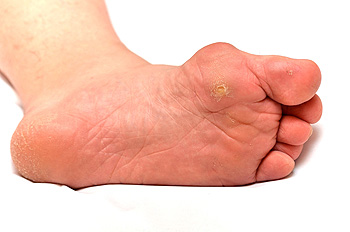 A large bump at the base of the big toe may be referred to as a bunion. It may cause the big toe to turn toward the second toe. The symptoms that are most often associated with bunions include pain, tenderness, or swelling surrounding the affected area. Bunions can develop for a variety of reasons. These include shoes that do not have adequate room for the toes to move freely in, genetic factors, or an injury that has occurred. If you are afflicted with this ailment, mild relief may be found by wearing shoes that fit properly or putting a protective covering over the bunion. If you have a bunion that is affecting your daily activities, it is advised to counsel with a podiatrist who can offer a treatment solution.
A large bump at the base of the big toe may be referred to as a bunion. It may cause the big toe to turn toward the second toe. The symptoms that are most often associated with bunions include pain, tenderness, or swelling surrounding the affected area. Bunions can develop for a variety of reasons. These include shoes that do not have adequate room for the toes to move freely in, genetic factors, or an injury that has occurred. If you are afflicted with this ailment, mild relief may be found by wearing shoes that fit properly or putting a protective covering over the bunion. If you have a bunion that is affecting your daily activities, it is advised to counsel with a podiatrist who can offer a treatment solution.
If you are suffering from bunion pain, contact Dr. Kenneth Donovan of Advanced Care Foot and Ankle. Our doctor can provide the care you need to keep you pain-free and on your feet.
What Is a Bunion?
Bunions are painful bony bumps that usually develop on the inside of the foot at the joint of the big toe. As the deformity increases over time, it may become painful to walk and wear shoes. Women are more likely to exacerbate existing bunions since they often wear tight, narrow shoes that shift their toes together. Bunion pain can be relieved by wearing wider shoes with enough room for the toes.
Causes
- Genetics – some people inherit feet that are more prone to bunion development
- Inflammatory Conditions - rheumatoid arthritis and polio may cause bunion development
Symptoms
- Redness and inflammation
- Pain and tenderness
- Callus or corns on the bump
- Restricted motion in the big toe
In order to diagnose your bunion, your podiatrist may ask about your medical history, symptoms, and general health. Your doctor might also order an x-ray to take a closer look at your feet. Nonsurgical treatment options include orthotics, padding, icing, changes in footwear, and medication. If nonsurgical treatments don’t alleviate your bunion pain, surgery may be necessary.
If you have any questions, please feel free to contact one of our offices located in Warren, Livingston, and Toms River, NJ . We offer the newest diagnostic and treatment technologies for all your foot care needs.
Are Bunions Affecting Your Everyday Life?
Are Bunions Affecting Your Everyday Life?
The Importance of Caring for Diabetic Feet
Elevated blood sugar levels are the main cause of diabetes. People who have this condition have to pay extra attention in caring for their feet. Diabetic patients may experience a tingling feeling or numbing sensation, and this can make it difficult in noticing any cuts that may be present on the feet. This type of nerve damage can lead to an infection and can cause gangrene if it is not treated promptly. Typical symptoms of a foot infection can include fever, unmanageable blood sugar levels, and skin discoloration. If you are a diabetic patient and would like information about taking care of your feet, it is advised to seek the counsel of a podiatrist who can properly guide you.
Diabetic foot care is important in preventing foot ailments such as ulcers. If you are suffering from diabetes or have any other concerns about your feet, contact Dr. Kenneth Donovan from Advanced Care Foot and Ankle. Our doctor can provide the care you need to keep you pain-free and on your feet.
Diabetic Foot Care
Diabetes affects millions of people every year. The condition can damage blood vessels in many parts of the body, especially the feet. Because of this, taking care of your feet is essential if you have diabetes, and having a podiatrist help monitor your foot health is highly recommended.
The Importance of Caring for Your Feet
- Routinely inspect your feet for bruises or sores.
- Wear socks that fit your feet comfortably.
- Wear comfortable shoes that provide adequate support.
Patients with diabetes should have their doctor monitor their blood levels, as blood sugar levels play such a huge role in diabetic care. Monitoring these levels on a regular basis is highly advised.
It is always best to inform your healthcare professional of any concerns you may have regarding your feet, especially for diabetic patients. Early treatment and routine foot examinations are keys to maintaining proper health, especially because severe complications can arise if proper treatment is not applied.
If you have any questions please feel free to contact one of our offices located in Warren, Livingston, and Toms River, NJ . We offer the newest diagnostic and treatment technologies for all your foot and ankle needs.
Possible Causes of Cracked Heels
When the skin on the heels become dry, a condition that is referred to as cracked heels may develop. This can happen from a variety of reasons. These include standing for extended periods of time throughout the day, wearing shoes that have an open back, or being obese. Additionally, existing medical conditions such as diabetes, eczema, or thyroid disorders can contribute to the formation of cracked heels. Mild relief may be found when the feet are soaked in warm water, followed by applying a moisturizer to the affected areas. There are patients who find it helpful to use oil on the heels, and then wearing socks to bed. If you have cracked heels and would like additional information on effective remedies, it is advised to seek the counsel of a podiatrist.
Cracked heels are unsightly and can cause further damage to your shoes and feet. If you have any concerns, contact Dr. Kenneth Donovan from Advanced Care Foot and Ankle. Our doctor can provide the care you need to keep you pain-free and on your feet.
Cracked Heels
Cracked heels appear unappealing and can make it harder for you walk around in sandals. Aside from looking unpleasant, cracked heels can also tear stockings, socks, and wear out your shoes. There are several methods to help restore a cracked heel and prevent further damage.
How Do You Get Them?
Dry skin is the number one culprit in creating cracked heels. Many athletes, walkers, joggers, and even swimmers suffer from cracked heels. Age and skin oil production play a role to getting cracked heels as well.
Promote Healing
Over the counter medicines can help, especially for those that need instant relief or who suffer from chronic dry feet.
Wear Socks – Wearing socks with medicated creams helps lock in moisture.
Moisturizers – Applying both day and night will help alleviate dryness which causes cracking.
Pumice Stones – These exfoliate and remove dead skin, which allows for smoother moisturizer application and better absorption into the skin.
Change in Diet
Eating healthy with a well-balanced diet will give the skin a fresh and radiant look. Your body responds to the kinds of food you ingest. Omega-3 fatty acids and zinc supplements can also revitalize skin tissue.
Most importantly, seek professional help if unsure how to proceed in treating cracked heels. A podiatrist will help you with any questions or information needed.
If you have any questions, please feel free to contact one of our offices located in Warren, Livingston, and Toms River, NJ . We offer the newest diagnostic and treatment technologies for all your foot care needs.
